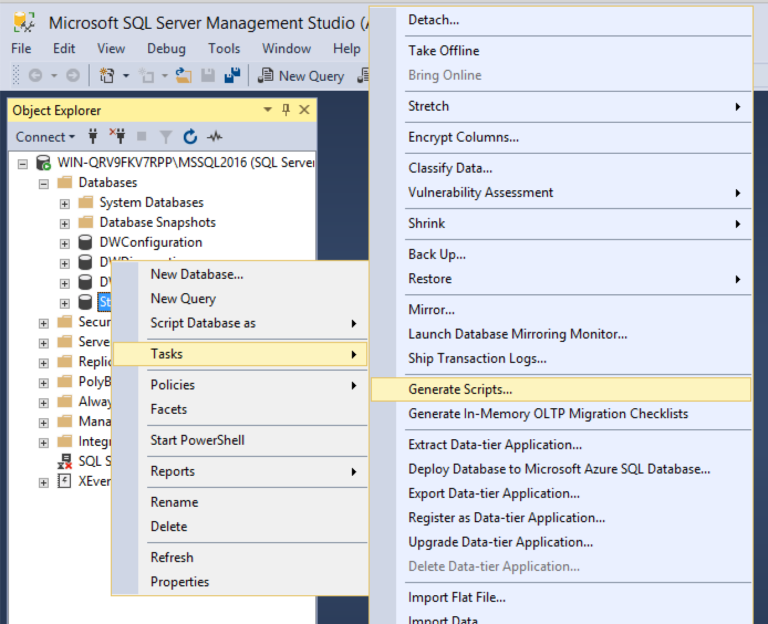
- #Sqlitestudio execute .sql script how to#
- #Sqlitestudio execute .sql script install#
- #Sqlitestudio execute .sql script code#
In closing, SQLiteStudio comes in handy for users who need to manage and alter SQLite databases by inserting new tables, views, triggers and indexes. In this manner, you can view specific information from each table, or gather data from multiple tables using INNER JOIN statements.Īlso, you can add a new trigger for the selected database by specifying its name, choosing its action, then writing the proper code. In case you want to insert a new table in the existing database, you need to choose the proper options, then specify the table name, set table constraints and add as many columns as you want.īy using the ‘SQL query editor’ option, located in the Tools menu, you are able to manually create your SQL scripts and execute them. The Tables menu allows you to erase data, as well as create a new table and populate it by specifying the number of rows you want to add.
#Sqlitestudio execute .sql script code#
After that, you can view all the existing data and manipulate it the way you want. To drop an existing trigger, you use the DROP TRIGGER statement as follows: DROP TRIGGER IF EXISTS triggername Code language: SQL (Structured Query Language) (sql) In this syntax: First, specify the name of the trigger that you want to drop after the DROP TRIGGER keywords. Additionally, you can import schema from other databases or from various file formats such as CSV and dBase. The hierarchical tree view allows you to select any table, trigger, procedure or statement and view the data in the main window.įrom the ‘Databases’ menu you are able to open a new *.db, *.sdb, *.sqlite or *.db2 file and connect to it using the right-click menu. The left panel displays all of the available databases along with their data. The name of the table cannot start with sqlite because it is reserved for the internal use of SQLite.
#Sqlitestudio execute .sql script install#
Since it does not require you to install it, all you have to do is to double-click the installer and start managing your SQLite databases effortlessly. First, specify the name of the table that you want to create after the CREATE TABLE keywords. The application comes with an intuitive interface and well-organized menus. Proc.Arguments = "/c sqlite3.exe """ + db3Path + """ < """ + sqlPath + """"ĭim elapsedMs = watch.ElapsedMillisecondsĬonsole.SQLiteStudio is a comprehensive and reliable SQLite database manager that provides you with a simple means of managing the contents of each database, including tables, triggers and views. Here's the code: Private Sub SQLiteButtonPress()ĭim baseDir As String = Application.UserAppDataPath() + "\Schema Scripts"ĭim db3Path As String = baseDir + "\ProgrammaticallyGenerateDatabase\Test.db3"ĭim sqlPath As String = baseDir + "\Baseline Schema.sql"ĭim watch = ()ĭim proc As New () I'm just bundling the sqlite3.exe with my application and calling it with the command line. I came up with a solution that works for my case. The code is running on a background thread and takes 483801 milliseconds to complete.
#Sqlitestudio execute .sql script how to#
I've tried using File.OpenText(sqlPath).ReadToEnd() but had the same performance issue.Īny ideas on how to speed this up? Just to reiterate, the same file runs in less than 1 second in the SQLite shell program using the. Sqlite_cmd.CommandText = "SELECT Type FROM Document_Type"ĭim sqlite_datareader = sqlite_cmd.ExecuteReader()ĭim textReader As String = sqlite_datareader.GetString(0) Sqlite_cmd.CommandText = File.ReadAllText(sqlPath) 'Dim sqlite_tran = sqlite_conn.BeginTransaction()

NET code: Dim baseDir As String = Application.UserAppDataPath()ĭim db3Path As String = baseDir + "\Schema Scripts\ProgrammaticallyGenerateDatabase\Test.db3"ĭim sqlPath As String = baseDir + "\Schema Scripts\script.sql"ĭim sqlite_conn = New SQLiteConnection("Data Source= " & db3Path)ĭim sqlite_cmd = sqlite_conn.CreateCommand() I plan on cleaning up the column types after I can get it to run in. INSERT INTO Learn_More (item_ID, field_name, description, location) VALUES (1, 'System Name', 'Full descriptive name of the system.* Example: Agency Billing System ', 'SSP1 ') INSERT INTO Document_Type (Id, Type) VALUES (3, '.jpeg') INSERT INTO Document_Type (Id, Type) VALUES (2, '.xlsm') INSERT INTO Document_Type (Id, Type) VALUES (1, '.docx') integer PRIMARY KEY AUTOINCREMENT NOT NULL, Below are five ways to run SQL scripts directly from a file in SQLite. This can be especially useful when you have a large script (such as creating a bunch of database tables and inserting data into those tables). File generated with SQLiteStudio v3.1.1 on Thu Feb 15 11:33:12 2018 SQLite provides us with the ability to run scripts directly from a file. Here's an excerpt from the script.sql file:. NET application it just hangs on sqlite_cmd.ExecuteNonQuery(). I know that the script works because when I run it in the SQLite shell application it executes in less than 1 second. I'm not sure how to optimize it to run faster. NET application but the run time is extremely slow.


 0 kommentar(er)
0 kommentar(er)
